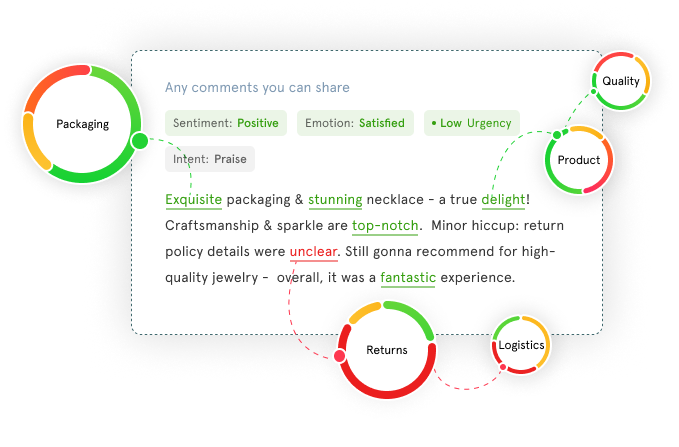You’ve just wrapped up another quarterly survey. But that’s not all that’s waiting for you. There are hundreds of survey responses in your inbox. Dozens of support tickets flagged for follow-up. Social media comments piling up. Chat transcripts from customer conversations. Maybe even online reviews trickling in with blunt honesty.
It’s a flood of customer feedback — scattered across channels, full of open-ended responses, and growing by the minute. Now you’re expected to make sense of it all. Spot the trends. Prioritize what needs fixing. Share insights with your team. And somehow do it all before the next fire breaks out. Sound familiar?
That’s the problem with traditional feedback analysis — it simply can’t keep up with the volume, speed, and complexity of customer input today.
This is where AI customer feedback analysis changes the game.
Instead of manually tagging or reading every comment, AI driven platforms use Large Language Models (LLM), Generative AI, Natural Language Processing (NLP) and Machine Learning (ML) to instantly analyze sentiment, identify recurring themes, and detect emotional drivers — across every touchpoint in the customer journey. It helps you understand not just what your customers are saying, but why they feel the way they do.
With AI, you can catch drops in satisfaction as they happen, automatically categorize feedback by issue, location, or product, prioritize improvements that impact loyalty, NPS, and revenue.
In this blog, we'll explore how AI-powered customer feedback analysis helps you turn overwhelming volumes of feedback into structured, strategic insight — so you can act faster and make data-driven decisions that drive results.
TL;DR
- AI customer feedback analysis uses LLMs, Gen AI, NLP and ML to automatically tag, analyze, and extract insights from open-text feedback across surveys, tickets, chats, and reviews.
- AI feedback analysis replaces manual tagging, inconsistent insights, and delayed reactions with real-time sentiment, intent detection, theme categorization, and urgency-based automation.
- From onboarding and product feedback to retention and brand advocacy, AI feedback analysis helps teams act faster, prioritize smarter, and scale customer-centric decisions.
- You can implement an AI feedback analysis by centralizing feedback sources, choosing the right AI tool, training it on your data, aligning with KPIs, and automating actions.
- Zonka Feedback is a customer experience software that helps you analyze, act, and close the loop, instantly and intelligently. With built-in AI feedback intelligence, it powers sentiment analysis, theme detection, and automated workflows that drive faster, smarter decisions. You can schedule a demo to learn more about it.
Analyze Customer Feedback Instantly with AI & Elevate CX
With AI feedback analysis, uncover emotion trends, surface hidden themes, and make smarter data-driven decisions.

What is AI Customer Feedback Analysis?
Modern businesses collect feedback from every touchpoint — post-purchase surveys, support tickets, website chats, app reviews, even social media threads. But analyzing that flood of data manually just isn’t sustainable.
AI customer feedback analysis solves this by using technologies like ChatGPT, Natural Language Processing, Machine Learning, and Sentiment Analysis to automatically organize, interpret, and extract insights from structured and unstructured feedback at scale.
The data can be classified into themes/topics, intent, sentiment polarity, and emotions. It can also detect churn, identify named entities, gauge urgency, and assess perceived effort. These form the building blocks that add intelligence to customer feedback analytics.
While the use of NLP and ML in customer feedback analysis is not new, Generative AI and LLMs have given it wings enabling thematic, sentiment, and qualitative analysis at scale. In the past, achieving contextual understanding required extensive training with traditional NLP and ML. With the emergence of large language models like ChatGPT, Claude, and Gemini, accuracy rates above 95% are now achievable when implemented effectively.
Rather than sifting through thousands of comments manually, AI does the heavy lifting in real time. Here's what that looks like in action:
- A product team receives 2,000 open-text survey responses after a new feature rollout. AI highlights a recurring frustration with one specific setting — within hours — allowing the team to ship a usability fix before it impacts churn.
- A CX leader monitoring support tickets across 15 branches uses AI to surface that delays in a specific region are driving negative sentiment. The team adjusts staffing within days, not weeks.
- A marketing team uses AI to analyze customer comments post-campaign. Sentiment analysis shows positive engagement, but entity recognition flags confusion around one offer term — enabling the team to clarify messaging mid-campaign.
AI doesn’t just categorize feedback — it adds context, reveals trends, and ties feedback to actions.

Key Components of Customer Feedback with AI
AI customer feedback analysis works by layering multiple intelligent systems together. These components help teams not only interpret what customers are saying, but also understand the sentiment, intent, and urgency behind it in real time, at scale. Here’s how each piece works:
- Sentiment Analysis: Automatically detects whether feedback is positive, negative, or neutral — helping you measure emotional tone across every stage of the customer journey. Ideal for spotting dips in customer satisfaction or rising frustration early.
- Theme Detection: Groups similar feedback into high-level themes or topics (e.g., pricing, support experience, product usability), enabling teams to instantly see what issues are surfacing most — without manual tagging.
- Entity Recognition: Extracts specific keywords such as product names, locations, features, or team mentions from free-text responses. This brings context to feedback, so insights can be filtered and segmented with precision.
- Impact Analysis: Connects feedback trends to business KPIs like NPS, CSAT, retention, or revenue. Helps identify which pain points have the biggest impact — so teams can prioritize what to fix first, with data to back every decision.
- Multilingual Processing: Analyzes feedback in multiple languages, making it possible to scale sentiment and theme detection globally — even in markets where localization has historically slowed feedback interpretation.
- Real-time Classification: Processes incoming feedback as it arrives and assigns relevant sentiment, tags, and themes on the fly — so your teams can monitor experience trends and take immediate action when needed.
- Workflow Automation: Triggers alerts, tags, or internal workflows based on feedback content or sentiment — enabling faster responses to negative experiences, smoother collaboration across departments, and consistent action on what matters most.
Strategic Benefits of Using AI Customer Feedback Analysis
AI customer feedback analysis isn’t just a smarter way to tag or summarize feedback. It’s a business advantage enabling you to move faster, think clearer, and act with confidence in an environment where customer expectations evolve by the minute. Here are the deeper benefits that AI customer feedback analysis unlocks:
- Speed Meets Scale without Resource Strain: Manually expanding feedback programs usually means hiring more analysts, stretching timelines, or narrowing scope. With AI, none of that is necessary. Whether you’re collecting feedback from five stores or five hundred, AI processes inputs in real time — without compromising quality. It’s how growing teams can scale customer experience operations without growing headcount.
- Brings Context to the Numbers: Quantitative CX metrics like NPS, CSAT, or CES only tell you what customers are feeling. AI helps explain why. By pairing scores with thematic and emotional insights, teams get a richer, more actionable picture — transforming numbers into narratives that inform real decisions. For instance, a sharp dip in NPS is paired with recurring mentions of “checkout wait time” and “staff shortage” — giving immediate direction for operations to investigate. That level of clarity is often buried in unstructured feedback, which AI brings to the surface.
- Eliminates Feedback Blind Spots: Feedback is often fragmented — collected through surveys, reviews, emails, chats, and more. AI brings it all together, analyzing across channels, formats, and teams. This eliminates the blind spots caused by siloed tools or manual workflows offering a unified view of customer sentiment across the entire journey. For instance, support feedback flagged no issues but AI picked up negative sentiment from social media and app reviews about long loading times. The insight would’ve been missed if channels were analyzed in isolation.
- Enables Predictive & Proactive Action: By identifying patterns over time, AI doesn’t just respond to issues — it helps anticipate them. Teams can catch early signals of churn, brand discontent, or product usability friction — and course-correct before those issues become costly. An uptick in neutral sentiment paired with keywords like “confusing,” “too many steps,” and “can't find” points to a UX friction before support volumes rise.
- Reduces Human Bias, Increases Insight Integrity: Manual feedback analysis often varies based on who’s doing the tagging or interpreting. AI uses consistent models trained on large datasets — removing individual bias and producing more reliable results. This ensures feedback analysis is not only faster, but more accurate, fair, and actionable across all teams and time periods.
- Builds Feedback into Business Strategy: When feedback flows into dashboards that connect to business KPIs — and triggers workflows automatically — it stops being an afterthought. It becomes a strategic input. AI makes this connection possible by structuring data, surfacing what matters, and feeding it directly into the systems where decisions are made.
Why Traditional Feedback Analysis Doesn’t Scale?
Let’s be honest — most traditional feedback workflows weren’t built for the speed, complexity, or volume of customer interactions today. They were designed for an era when surveys were quarterly, reviews were occasional, and tickets were manageable. But now feedback comes in 24/7 — from surveys, emails, chats, reviews, and more — and it demands real-time understanding.
Here's why the old approach simply can’t keep up and how AI Feedback Analysis is needed:
| Dimension | Traditional Feedback Analysis | AI Customer Feedback Analysis |
| Speed of Insight | Delayed — insights surface days or weeks later, often after the damage is done | Real-time — instant analysis across all channels |
| Scalability | Manual effort grows with volume — more data means more people, more time | Effortless — handles thousands of responses per day without extra resources |
| Accuracy & Consistency | Subjective — tagging and categorization vary by person or team | Consistent — AI applies the same logic across all feedback, every time |
| Handling of Unstructured Feedback | Often ignored or simplified due to complexity | Seamlessly analyzes open-text, reviews, chats, and more — turning unstructured feedback into rich insights |
| Cross-Channel Feedback | Fragmented — feedback lives in disconnected tools and formats | Unified — surveys, tickets, reviews, and social comments all analyzed together |
| Proactive Issue Detection | Reactive — trends spotted only after escalation | Predictive — surfaces emerging issues and sentiment shifts early |
| Connection to Business Outcomes | Loose — hard to tie insights to KPIs like NPS or churn | Direct — maps feedback to impact metrics, decision priorities, and team actions |
| Collaboration & Actionability | Slow — insights take time to compile, share, and act on | Instant — workflows, alerts, and dashboards ensure feedback reaches the right team fast |
That being said, traditional tools may help you collect feedback — but they don’t help you use it effectively. If your team is still spending hours reading comments, struggling to align insights across tools, or reacting to problems too late, it's a sign your analysis approach hasn’t scaled with your business. AI customer feedback analysis gives you a smarter, faster, and far more strategic alternative — one built for how customers communicate today.
The Hidden Risks of Manual Feedback Analysis (& How AI Quietly Fixes Them)
AI feedback analysis doesn’t just accelerate insights or unlock deeper customer understanding — it also solves the everyday inefficiencies that often go unnoticed. These operational issues silently drag down your team’s productivity, slow your CX decisions, and erode data accuracy.
Here’s what AI feedback intelligence eliminates — behind the scenes — to help your teams move faster, cleaner, and smarter.
- Inconsistent categorization: AI algorithms can categorize and tag feedback consistently and accurately, reducing the likelihood of inconsistencies or misclassifications that may occur with manual categorization by different individuals or teams.
- Missed Insights: AI can analyze large volumes of feedback datasets quickly and comprehensively, ensuring that no valuable insights or trends are overlooked due to human limitations in processing vast amounts of information within a limited time frame.
- Biases in Analysis: AI feedback analysis can mitigate biases that may inadvertently influence human analysts' interpretations of feedback data, such as confirmation bias or subjective judgment. AI algorithms process data objectively based on predefined criteria, reducing the risk of biased analysis.
- Delayed Response Time: AI-driven real-time analysis enables businesses to respond promptly to customer feedback, minimizing delays in addressing issues or concerns raised by customers and preventing dissatisfaction resulting from slow response times.
- False Positive/Negative: AI algorithms can reduce the occurrence of false positives (misidentifying non-issues as issues) and false negatives (failing to identify actual issues) by applying sophisticated pattern recognition and natural language processing techniques to accurately detect meaningful insights from feedback data.
- Language Barriers: Most AI-driven feedback systems work in multiple languages and would instantly translate feedback to analyze sentiments and overcome any language barrier.
- Sentiment-based Actions: You can also set-up AI-sentiment based workflows to ensure that feedback reaches the right team or person based on the emotions, intent, or urgency detected by AI feedback analysis.

How AI Transforms Feedback Analysis?
Using AI, ML, and LLMs for customer feedback analysis can offer multifold benefits to businesses across every industry. But how does it actually work? How does incorporating AI in customer feedback analysis methods change the way businesses unlock customer insights?
Imagine algorithms that can swiftly categorize and group feedback based on sentiment, and key themes, and even automatically labeling them. This translates to actionable insights delivered directly to product managers and engineers – all at lightning speed. The benefits are twofold: significant time saved and a boost in both the accuracy and consistency of feedback analysis.
Let’s quickly go through the different ways AI is transforming feedback analysis.
1. Automated Sentiment Analysis
Humans possess the ability to identify sentiments. Now imagine, assigning a team of professionals to go through the hundreds and thousands of feedback comments received on your system to analyze the sentiments hidden behind them.
Seems like an impossible feat to achieve, right?
But if someone did try to achieve it, they would need to invest a huge amount of resources, time, energy, and effort to make a group of people sit around, go through every comment one by one, scan through the text data, and feed the sentiments alongside.
Enter Artificial Intelligence.
Today, AI algorithms can be trained on large, multiple datasets to quickly analyze the sentiments expressed in customer feedback. Based on the data fed into the algorithms, it can identify patterns and indicate text as positive, negative, or neutral.
Our sentiment analysis tool continuously feeds on the data collected by our clients so that it can deliver more accurate results.
Not only can it generate sentiment scores, but it also gives sentiment breakdown, compares with previous periods, and highlights the sentiments over time to identify trends and changes.
2. Identification of Customer Intent & Its Analysis
Customer, user, or buyer intent is the determining force in any business success. It helps identify the underlying reason for the feedback and the intention behind that feedback.
Feedback can have different intents- praise, complaint, suggest, recommend, question, inform, and much more. What an AI survey tool does is, it recognizes that intent automatically from the responses received and understands what the respondent really is trying to say, and moreover, their underlying intention of how they want to engage.
With intent analysis, businesses can identify the underlying purpose behind feedback and take action to increase the chances of conversion, retention, and delight.
Let’s say, Stephen has left the following feedback on your store:
"These sneakers looked amazing online, but the quality is terrible! They ripped after just one wear. Really disappointed."
Using AI for customer feedback analysis, we can know that the customer's intent is to complain and show dissatisfaction with the product quality.
This can be further streamlined when viewing all the responses with similar intent.
3. Prioritizing Tasks Based on Urgency
An AI-driven survey platform can instantly help your teams prioritize tasks based on urgency. In any crisis, AI can tag it as a high-urgency task and intimate users to take action on it. With human intervention, these issues can be resolved easily.
For instance, you are taking product feedback and a user has reported a bug in one of the features. AI would tag it as High Urgency, marking it in red, so that it can be taken into consideration quickly. Further, by pairing it with CX automation, the customer feedback analysis tool can also send alerts to the required team or team member, create a ticket in the integrated systems, or even send out an automated email to close the feedback loop.

4. Automated Identification of Entities From Unstructured Feedback
Unstructured data from open-ended questions is one of the biggest challenges faced by businesses aiming for standardized feedback analysis. With Natural Language Processing algorithms, businesses can train their AI models on large unstructured datasets to extract actionable insights.
LLMs and LP can then identify the key entities through a process known as Named Entity Extraction. It can detect and categorize important entities in text data such as name, location, organization, person, product, service, amenities, competitor, etc.
For instance, you’re performing hotel surveys, and here’s some feedback that you’ve received:
"I love your store on Main Street! Always find something new and exciting. However, Stephen at the store wasn't very helpful today. He could not assist me when I asked for a different size."
A standard customer feedback system would’ve flagged this as a negative review without giving specific details of what’s negative about it.
Here’s how Gen AI and NLP would’ve done entity recognition:
Location: Main Street
- Sentiment: Positive
- Urgency: Medium
- Emotion: Satisfied
- Intent: Praise
Staff: Stephen
- Sentiment: Negative
- Urgency: High
- Emotion: Anger
- Intent: Complain
This way, one can easily get a quick glance at what the customers actually like at the store and what areas of the store require more attention.
5. Automated Tagging & Topics Assigning to Discover Hidden Patterns
Manually skimming through each and every comment to identify similar issues could take up days and weeks for any particular campaign. With an AI engine powering your feedback tool, you can expect nothing but automated tagging and topic assigning along with themes and sub-themes to organize your feedback into similar groups.
These AI survey tools are powered by topic modeling. This technique helps discover main themes and sub-themes in large data of text feedback.
For example, a business collecting hotel feedback would have several topics like-
- location
- staff
- amenities
- facilities
- cleanliness
- price
- food
- services
What topic modeling in a survey tool does is it clubs together feedback talking about these themes and even goes further to bifurcate them into different sub-themes.
So, here the large topics would be facilities, cleanliness, location, staff, amenities, services, price, food, etc. And every sentiment around that topic would be displayed in front of it.
 Our feedback software not only automatically detects the major recurring themes, topics, sub-themes, and tags, but also allows them to manually add tags based on the categorization they desire.
Our feedback software not only automatically detects the major recurring themes, topics, sub-themes, and tags, but also allows them to manually add tags based on the categorization they desire.
You can easily put your model into learning mode to view suggestions of new tags, themes, sub-themes as more and more reviews come in that can be added to the company’s custom AI model.
Even for tagging, there can be an option where it would match feedback with existing tags, suggest new tags based on text analysis, or automatically generate new tags.
6. Highlighting Text Based on Emotions Detected
Not every feedback would be white or black (read positive or negative). There would be a lot of gray space. This is where neutral or mixed sentiments come in.
Any customer feedback can have multiple negative or positive statements. With emotion detection technology in AI-driven feedback analysis software like Zonka Feedback, you will also get all the negative as well as positive statements within the text highlighted in red or green. This would be in addition to the overall sentiment that would be shown alongside the feedback.
The image below showcases how a feedback comment would look once AI has worked its magic on analyzing the sentiments and highlighting statement-based sentiments.
7. Tracking Sentiment Trends Over Time
Understanding how customers feel today is useful — but what’s even more valuable is knowing how those feelings have evolved over time. AI survey tools allow teams to track sentiment shifts by week, month, or quarter. They highlight recurring pain points or emerging improvements, helping teams move from reactive to proactive.
If feedback sentiment for a product feature starts declining after an update, you catch it early — before support tickets spike or churn increases.
8. Comparative Theme Analysis Across Teams, Products, or Locations
When you’re running operations across multiple teams, products, or branches, it’s not enough to know what’s being said — you need to know where it’s being said, how often, and by whom. AI theme detection, combined with smart filters and dashboards, helps teams compare feedback patterns across business units — so they can understand what's working well and where interventions are needed.
Think of being able to compare "Support Experience" themes across 10 store locations, instantly seeing which one drives the most positive sentiment — and where complaints about agent behavior are rising.
9. AI-Powered Suggestions for Closing the Loop
Responding to feedback — especially when it’s negative — is critical, but resource-intensive. AI can assist by suggesting empathetic, context-aware replies based on sentiment, urgency, and themes detected. This helps frontline teams move faster and stay consistent, while still keeping the human touch.
A comment flagged as negative with high urgency could trigger a recommended response that includes an apology, explanation, and an invitation to continue the conversation.
Use Cases & Applications of AI Feedback Analysis
AI-powered feedback analysis unlocks value across every stage of the customer journey based on business goals helping teams move faster, align smarter, and deliver results that tie directly to core business objectives — whether it's improving adoption, reducing churn, or optimizing brand perception.
Here’s how it shows up across the journey:
1. Onboarding — Reduce Friction & Improve Time-to-Value
The first moments after signup or onboarding are critical. Frustration here leads to early drop-off — something AI helps prevent by identifying blockers before they scale. AI enables teams to:
- Detect recurring confusion or complaints around feature discoverability
- Spot intent like “need help”, “don’t understand”, or “not working” across hundreds of responses
- Track sentiment linked to first-week experiences and highlight negative shifts early
AI also flags issues before they escalate, helping you address concerns proactively and prevent dissatisfaction during these high-stakes first impressions. This gives product and onboarding teams a clear view of where customers are struggling, allowing them to deliver proactive help, fix usability issues, or refine the welcome experience without waiting for attrition metrics to catch up.
2. Product Engagement — Prioritize What to Build, Fix, or Improve
Once users begin actively engaging, the volume and complexity of feedback increases. AI helps product teams stay ahead by filtering noise and surfacing signals tied to product adoption, usage, and satisfaction. Through:
- Auto-tagging feedback related to specific features or workflows
- Grouping comments into themes like speed, intuitiveness, design, or errors
- Monitoring sentiment changes after a new release or change
Instead of working from assumptions, product managers gain precision — using AI to identify specific frustrations, requests, or praise linked to feature usage, so they can improve what matters most. This allows teams to confidently prioritize updates or fixes based on data, not anecdote — speeding up product-market fit and innovation cycles.
3. Customer Support & Resolution — Respond Faster, Reduce Escalations
Support teams deal with the sharp edge of customer frustration. AI ensures they’re not just reacting — but prioritizing and resolving more strategically. Key capabilities include:
- Detecting high-urgency sentiment or keywords like “angry,” “disappointed,” or “broken”
- Auto-routing critical feedback to the right team based on issue type
- Flagging repeat issues or themes that suggest systemic service gaps
AI also helps eliminate manual errors, missed signals, and categorization inconsistencies — ensuring critical feedback is identified accurately and routed without delay. This transforms support feedback from a chaotic stream into a source of operational insight — helping teams reduce resolution times, improve SLA adherence, and proactively close the feedback loop on recurring complaints.
4. Retention & Renewal — Identify At-Risk Customers Early
When users are approaching renewal — or thinking about leaving — their feedback becomes sharper, more honest, and more revealing. AI helps teams spot those signals when there’s still time to intervene. By:
- Analyzing patterns in exit surveys, plan downgrade comments, or silent drop-offs
- Highlighting intent phrases like “not worth it”, “too expensive”, “considering alternatives”
- Tying recurring negative sentiment to churn drivers like pricing, value perception, or missing features
AI-powered analysis helps uncover emerging dissatisfaction trends and surface the early signs of churn that would otherwise go unnoticed — enabling teams to act decisively before it’s too late. Retention teams can then act quickly — whether by personalizing outreach, refining pricing models, or improving the perceived value of underused features — all grounded in real customer input.
5. Advocacy — Amplify Promoters & Optimize Messaging
Positive feedback is more than just a feel-good metric. AI helps teams turn it into strategic advantage — identifying advocates and refining what makes them loyal. Here’s how:
- Detecting praise intent and promoter sentiment in NPS or CSAT responses
- Surfacing emotional keywords tied to positive experience drivers (e.g., ease, delight, responsiveness)
- Tracking which features, moments, or campaigns generate the most advocacy
By providing insights into the emotional language and themes tied to loyalty, AI helps marketing and CX teams create messaging and experiences that resonate deeply and consistently. These insights power referral campaigns, case study outreach, and high-impact customer stories — while reinforcing what’s working across the journey.
How to Implement AI Feedback Analysis?
AI feedback analysis offers immense value — but it’s only effective when implemented with clarity and alignment. Whether you're starting from scratch or upgrading from manual workflows, here’s how to approach AI feedback implementation in a way that drives real results.
1. Start by Centralizing Your Feedback Sources
Before AI can do its job, your feedback needs to be consolidated.
Surveys, reviews, support tickets, chat logs, and social feedback often live in silos. Integrate these into a single platform or pipeline that allows for unified analysis.
- Connect feedback from multiple channels (email, survey, web, chat)
- Ensure historical data can be imported for AI to learn from trends
- Eliminate duplication or fragmented views across departments
2. Choose the Right AI-Enabled Feedback Tool
Not all AI insight tools are created equal. The more flexible and intelligent the engine, the better it will scale with your growth. Look for a platform that offers:
- Uses Generative AI and LLMs for contextual understanding
- Built-in NLP and sentiment analysis
- Theme and entity detection to extract context
- Real-time processing and auto-tagging
- Custom AI models that can learn your industry language
- Multilingual support to analyze global feedback
- Integrations with your existing CRM, helpdesk, or communication tools
3. Train AI Models With Your Own Data
To get relevant insights, the AI needs to understand your world. Train your model using past customer feedback to fine-tune tagging, sentiment calibration, and entity recognition.
- Use your historical feedback to “teach” the AI what matters
- Define custom tags or themes specific to your business (e.g., “KYC delay,” “checkout lag,” “OTP failure”)
- Allow for continuous learning so the model adapts as your feedback evolves
4. Align AI Analysis with Business Goals
Feedback only becomes valuable when tied to outcomes.
- Map AI-detected themes and sentiment trends to KPIs like NPS, retention, churn risk, or conversion
- Configure dashboards for different roles — so CX, product, and marketing teams see what matters most to them
- Set up workflows that route feedback to the right team based on intent or urgency (e.g., “feature request” to product, “churn risk” to retention)
5. Automate Action — Don’t Just Analyze
AI-driven feedback analysis shouldn’t stop at insight — it should lead directly to action.
- Use sentiment-based triggers to create support tickets, send alerts, or flag urgent issues
- Close the loop automatically by triggering follow-ups, acknowledgment messages, or retention workflows
- Monitor resolution rates and customer satisfaction post-response to complete the feedback cycle
6. Continuously Monitor and Refine Your Model
Feedback data evolves — and your AI should too. Make this an ongoing process — not a one-time setup — to keep your analysis aligned with customer expectations and business strategy.
- Review false positives/negatives and adjust tagging models
- Evaluate accuracy and relevance of entity recognition
- Refine alert thresholds for urgency, negative sentiment, or complaints
Zonka Feedback’s AI-driven Feedback Analysis in Action
Theoretical knowledge of AI, LLMs and NLP technologies isn’t enough for a business like yours to gain a competitive advantage. You need to get into the practicality of things. With the abundance of customer feedback analysis tools available, it's crucial for businesses to select the right one.
Zonka Feedback is an AI-powered customer experience and feedback management software that turns your customer feedback data into actionable insights. From feedback collection to reporting and analysis and closing the feedback loop, it incorporates AI in every aspect. However, the major business advantage lies in its AI feedback analysis. Here's how:
- AI-Powered Sentiment Analysis Across the Customer Journey: Zonka Feedback doesn’t just tell you if a customer is happy or frustrated — it shows you when, where, and why. Every comment is scanned for emotional tone, scored for intensity, and tagged with sentiment — positive, neutral, or negative — all in real time. Whether it’s a spike in post-support frustration or a dip in feature sentiment after a product release, you know exactly when emotions are shifting — and what’s driving it.
- Theme Detection That Surfaces What’s Trending: Manually tagging thousands of feedback entries into usable themes isn’t scalable. Zonka’s AI organizes every open-text comment into key topics and sub-themes like “Billing,” “App Speed,” or “Staff Behaviour.” The result? Clean, categorized insights that let teams compare feedback patterns across time, product areas, or customer segments — without lifting a finger.
- Entity Recognition That Adds Context to Every Comment: Feedback without context is a dead-end. Zonka Feedback uses AI-based entity recognition to detect specific names, locations, product references, or service terms from within feedback. Whether someone mentions “Stephen at the downtown branch” or “payment failed on checkout,” those specific entities are tagged and made searchable — turning vague complaints into actionable intel.
- AI Smart Summaries That Save Hours of Reading: Going through every single open-ended comment? Not happening. Zonka’s Smart Summaries condense long, rambling feedback into short, contextual briefs — highlighting sentiment, intent, and theme in one snapshot. No more drowning in data — just skimmable summaries that help product, CX, and ops teams get to the point faster.
- Urgency Detection to Escalate Critical Feedback: Some feedback can wait. Some can’t. Zonka’s AI detects urgency based on keywords, tone, and emotional language — flagging critical issues like “broken,” “unusable,” or “cancelling” in real time. That means your team doesn’t just respond fast — they respond smart. Urgent issues are auto-tagged, escalated, and tracked for follow-up so nothing gets lost in the queue.
- Workflow Automation That Closes the Loop Automatically: Once AI insights are in, Zonka makes sure action follows. Based on sentiment, urgency, or theme, teams can trigger workflows: assign support tickets, send Slack alerts, log product feedback, or escalate critical cases. For instance, a feedback tagged with “High Urgency” and “Churn Risk” can auto-trigger an alert to the retention team — so the right person follows up at the right time.
- Role-Based Dashboards That Deliver the Right Data to the Right Team: Insights are only useful when they reach the right hands. Zonka Feedback’s multilevel dashboards and smart filters let you slice data by region, team, customer segment, or product line — so leaders only see what’s relevant to them. A CX leader sees sentiment shifts across the journey. A product manager sees feedback trends by feature. An ops head sees support issues by store. Everyone sees what matters — without digging.
- Custom AI Models That Speak Your Business’s Language: No two businesses sound the same. Zonka Feedback lets you build and train custom AI models on your own data — so it understands your products, services, and terminology. Instead of treating “OTP failure” as a generic bug, the system learns that it's a friction point in account activation — and flags it as a conversion risk. The more feedback you get, the smarter the model becomes.
Conclusion
Customer feedback is no longer something you review at the end of the month — it's a living, evolving source of insight that can shape products, improve experiences, and drive retention. But to unlock its full potential, you need more than spreadsheets and siloed survey tools.
With AI-powered customer feedback analysis, you can move beyond reading comments to actually understanding your customers — their emotions, their frustrations, their expectations. It’s how modern teams are scaling CX insights without scaling headcount, closing the loop faster, and acting on what matters most.
Zonka Feedback brings AI into every step of your feedback workflow — from real-time sentiment and intent detection to theme analysis and automated response workflows. The tool’s Analytics dashboard is lined with the latest reports including text analysis, sentiment analysis, and topics that will share a drill-down report of how the customers are feeling.
You can get early access to our upcoming AI Feedback Intelligence launch or explore our existing suite of features. Get started now to turn every customer comment into an opportunity to listen better, improve faster, and drive impact where it matters!











